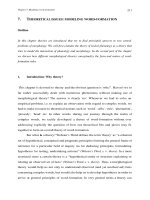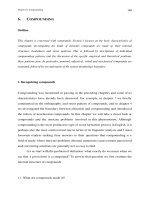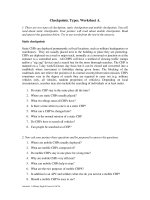Section Formation - Worksheet
Bạn đang xem bản rút gọn của tài liệu. Xem và tải ngay bản đầy đủ của tài liệu tại đây (110.5 KB, 16 trang )
Section Formation: Worksheet
Soldiers who are in a rifle section move as part of that section. The way they move as
a section is called a section formation
1. In pairs, look at the following pictures of section formations and talk about what are
their strengths and weaknesses and when they would be used. Reproduced from A
SOLDIERS POCKET BOOK ISBN 1-874528-02-0 with the permission of Military
Pocket Books Ltd
2. The kind of section formation used depends on six things. What are those six
things?
Attention! A Military English Course for NCOs
3. Here are the six factors that you have to think about when deciding on what
formation to use. Match these factors with the reasons why they are important.
1. The country you are crossing a) You must be able see hand signals clearly
2. The likely direction of enemy fire b) Are you likely to be attacked by a plane
3. How far you can see c) You don’t want to shoot your friends
4. How the section can best be controlled d) It may slow you down
5. Need to produce minimum fire effect e) All soldiers must hear orders easily
6. Who controls the air space f) You must be able to return fire easily
4. These are the names of the section formations in the pictures. Match the names with
the pictures.
a) Diamond b) Arrowhead. c) File. d) Extended Line e) Single File.
5. Below are some of the good and bad points of Section Formations. Match them
with a type of formation, use “D” for Diamond, “A” for Arrowhead, “F” for file, “EL”
for Extended Line and “SF” for Single File. Some of the points will be used for more
than one type of formation.
a) Good for crossing open country at night
b) Good for keeping control
c) Has all round observation and protection
d) Firing to the front is restricted
e) The section commander can be at the front or in the middle
f) Good for moving across open country
g) Produces effective fire against an enemy frontal attack
h) Good for an assault on enemy positions.
i) Good for moving along hedges or the edges of woods
j) Bad because it makes a good target for the enemy
k) Good for movement at night
l) Difficult to control
m) Difficult to control, especially when engaged from the flanks
6. Work in pairs: There are six key things a rifleman should do when moving in
section formation. Discuss what those six things are.
7. Now read the text about Section Formations. Check the answers you have given on
this worksheet.
8.Work in pairs. Now prepare and give a briefing on section formations. Make notes
about each type of section formation and practice giving the briefing with your
partner.
Attention! A Military English Course for NCOs
Section Formation: Text
"Reproduced from A SOLDIERS POCKT BOOK ISBN 1-874528-02-0 with the permission of
Military Pocket Books Ltd"
As a member of a rif
l
e section you move as part of your section. How you move
depends on six factors.
The country you are crossing
The likely direction of enemy fire
How far you can see
How the section can best be controlled
Need to produce minimum fire effect
Who controls the air space.
You may move in
Single file
This is good for - moving along hedges or the edges of woods Good control, -
especially at night. Makes a good target for the enemy. Firing to the front is restricted.
File
This is good for – control of movement, movement at night, but - Makes a good target
for the enemy
Arrowhead
This is good for – Moving across open country – Producing effective fire against
enemy frontal attack. But – difficult to control, especially when engaged by flanking
fire.
Diamond
Formation only used when crossing open country at night. Easy to control., has all
round observation and protection, each person can see next, the Section Commander
can be at the front or the middle.
Extended Line.
This is a good formation for an assault on enemy positions, but difficult to control.
Remember.
When moving a section in formation
Watch your section commander for hand signals.
Keep in contact with members of the section on each side of you –but not too close.
Keep quiet and listen to commands and anticipatory orders.
Keep in correct position for formation
Be observant
Be ready to change to a new section formation.
Attention! A Military English Course for NCOs
Section Formation: Answer Key
1. In pairs, look at the following pictures of section formations and talk about what are
their strengths and weaknesses and when they would be used. Reproduced from A
SOLDIERS POCKET BOOK ISBN 1-874528-02-0 with the permission of Military
Pocket Books Ltd
Single File
File
Arrowhead
Diamond
Extended Line
2. The kind of section formation used depends on six things. What are those six
things?
The country you are crossing
The likely direction of enemy fire
How far you can see
How the section can best be controlled
Need to produce minimum fire effect
Who controls the air space
3. Here are the six factors that you have to think about when deciding on what
formation to use. Match these factors with the reasons why they are important.
1. d 2. f 3. a 4. e 5. c 6. b
5. Below are some of the good and bad points of Section Formations. Match them
with a type of formation, use “D” for Diamond, “A” for Arrowhead, “F” for file, “EL”
for Extended Line and “SF” for Single File. Some of the points will be used for more
than one type of formation.
a) Good for crossing open country at night D
b) Good for keeping control SF, F, D
c) Has all round observation and protection D
d) Firing to the front is restricted SF
e) The section commander can be at the front or in the middle D
f) Good for moving across open country A
g) Produces effective fire against an enemy frontal attack A
h) Good for an assault on enemy positions. EL
i) Good for moving along hedges or the edges of woods SF
j) Bad because it makes a good target for the enemy SF, F
k) Good for movement at night F
l) Difficult to control EL
m) Difficult to control, especially when engaged from the flanks A
7. The six things a rifleman should do are.
Watch his section commander for hand signals.
Keep in contact with members of the section on each side of you –but not too
close.
Keep quiet and listen to commands and anticipatory orders.
Keep in correct position for formation
Be observant
Be ready to change to a new section formation.
Types of Patrol Tapescript
So, today I’m going to tell you about different types of patrol. I will tell you about four
types of patrol. They are Reconnaissance patrols, Standing Patrols, Fighting Patrols and
Escort Patrols. I will tell you four things about each of those patrols. I will tell you the
aim of the patrol, the number of men needed for the patrol, the weapons and equipment
needed for that patrol and I will comment on anything special about those patrols.
Understand. OK.
So, lets begin with reconnaissance patrols, or recce patrols as they are usually called. The
aim of a recce patrol is to gain information from and about the enemy. Where they are.
How many of them are there. What equipment they have. That sort of thing. Now for a
reconnaissance patrol you need 3 to 5 men. Recce patrols are small because they should
not be seen by the enemy and should not engage the enemy, so three to five men. Recce
patrols should travel quietly, so they take the minimum about of weapons and equipment.
They should have only their personal weapons and a radio. A special comment about
Rece patrols. The men must be very fit and must be able to operate without resupply for a
long time. So that’s Reconnaissance Patrols or Recce Patrols as we call them.
Lets move on to Standing Patrols. Standing Patrols stay in one place. They don’t travel.
Now, the purpose of a standing patrol is to warn of enemy movements. They do this by
watching approaches and dead ground. Now the Standing Patrol is larger than the Recce
patrol. It has up to 8 men. And they are more heavily armed. They have their personal
weapons, which would include machine guns and anti-tank weapons, and they have
communications equipment. Now, a special comment about Standing Patrols, they have
to be heavily armed and ready to fight. And they must stay hidden until they contact the
enemy. So, that’s Standing Patrols.
What about Fighting Patrols? Well, the purpose of fighting patrols is to attack the enemy.
Because of this they have to be very large. Usually the whole platoon that would be
twenty four men. And because they have to fight, they should take as many weapons as
possible. Special Comments. Well, they should be well prepared with good intelligence
from reconnaissance and they should be ready to fight. So, that’s the Fighting Patrol.
And finally, there is the Escort Patrol. Now the aim of the Escort Patrol is to provide
security of personnel or vehicles on the move. Things like important politicians going to
meetings or food supplies being transported to warehouses. Well, its hard to say how
many men are needed to do an escort patrol. It depends on the task. And as for weapons,
well, and Escort Patrol usually takes as many weapons as possible. And, what extra
comment can I make. Well, Escort Patrols should always expect trouble and be prepared
for it.
So, that’s the four types of patrol. Recce Patrol, Standing Patrol, Fighting Patrol and
Escort Patrol and their aims, the amount of men they need, the weapons and equipment
they use and special comments about them. Hope you’ve learnt something from this little
talk.









